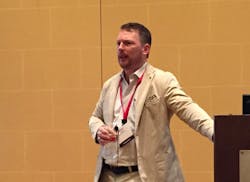Braskem—made the leading petrochemical company in the Americas and one of the largest in the world by the merger of six companies in 2002—has 40 industrial units around the world. Along the way, Braskem acquired four polypropylene manufacturing sites from Dow Chemical, two of which were strapped with Dow’s proprietary MOD 5 distributed control system (DCS). With the hardware being quite old and the availability of spare parts dwindling, Braskem set out to migrate the systems over to Honeywell’s Experion PKS R430 DCS.
The first migration was completed in September at Braskem’s site in Schkopau, Germany. It was deemed such a success by management that the pressure is now on to complete migration (to a PKS R431) at a site in Oyster Creek, Texas, by 2017. “Since the cutover, we’ve had no DCS-related shutdowns, which is a real testament to the team,” said Michael Martin, senior process controls engineer at Braskem, who detailed the Schkopau migration for attendees of the Honeywell Users Group Americas this week in San Antonio, Texas.
Dow Chemical developed the MOD (Manufacturing Operating Discipline) process control system decades ago as part of its efforts to create a standardized, integrated process system. With a lack of suitable commercial systems at the time, everything was developed in-house along with other proprietary automation solutions. Dow began using the fifth iteration of the system (MOD 5) in 1980.
As great an accomplishment as this was for Dow—a multi-disciplinary collaboration that provided real operation benefits—the DCS was an unwieldy beast for Braskem. It was a very risky and complicated migration, Martin said, with several significant challenges. But the Schkopau site has also benefited from many new technologies and capabilities, and production rates and uptime are better than yearly goals.
The Schkopau site’s migration from the MOD 5 to the Experion R430 was a large effort that included:
- About 7,000 I/O
- More than 700 graphics
- More than 1 million lines of code and comments
- More than 6,000 MOD 5 modules migrated to 4,500 Experion control modules
- More than 50,000 AspenTech IP21 historian tags
- Data links from nine Siemens gas chromatography analyzers migrated to Modbus TCP via peer control data interface (PCDI) blocks
- Development of more than 30 module templates
System development was done in the cloud across the globe, which Martin said was critical to making the project a success.
The MOD 5 itself was a challenge, Martin said. It was difficult to understand its state-based code and automation architecture, which was necessary to replace the sequence for each unit with sequence control modules. “Going into this project, nobody knew what the MOD 5 was,” he said.
Migration involved identifying and developing similar functionalities to the existing HMI, and translating and normalizing MOD 5 equations. The MOD 5 uses logic to enable and disable alarms, so Braskem’s engineers had to figure out how to program this and effectively visualize alarm status and trip points. They replaced the MOD 5’s combined process and instrumentation failure alarms with Experion single alarming and custom faceplates. The interface to third-party devices was replaced with PCDI and Modbus TCP.
The MOD 5 was both the basic process control system (BPCS) and safety instrumented system (SIS), Martin said. “So we had to break that apart and create a separate safety system.”
The migration has done a lot to improve the HMI graphics as well. Martin detailed how the legacy graphics needed more space for shapes and additional symbols for alarms and logic. The Experion graphics have dynamic alarm symbols, make additional symbols unnecessary, replace FC/FO text with arrows, and take much less space with shapes. The graphics also include enhanced system status.
New technologies and capabilities include:
- A virtual solution for L3.0 and L3.5 servers/PCs, which provides virtual machine replication across redundant host servers and rapid deployment of new servers/PCs.
- Integrated disaster recovery, including automated Acronis backups for all physical servers/PCs, automated virtual machine replications and backups, and tape backup for offsite storage.
- AspenTech IP21 data link migrated to OPC, which provides improved architecture with redundant data collectors and Experion’s redundant OPC servers, and 10x greater data resolution.
- GPS radio, with times synchronized from the C300 controllers to the IP21 server.
- Field Device Manager (FDM), used to interface with more than 800 DCS and SIS HART devices.
- Metso PlantTriage loop tuning, which minimized plant optimization efforts after the successful plant startup.
- Safety Manager, which uses new CDA integration to control builder and HMI graphics, and universal Rusio I/O modules that are HART-enabled.
Martin said that Braskem has been pretty happy with the final delivery of the Honeywell DCS. “We had some key operators that really exceeded our expectations and helped make it a success,” he said. “Without their buy-in, it will never be a success.”

